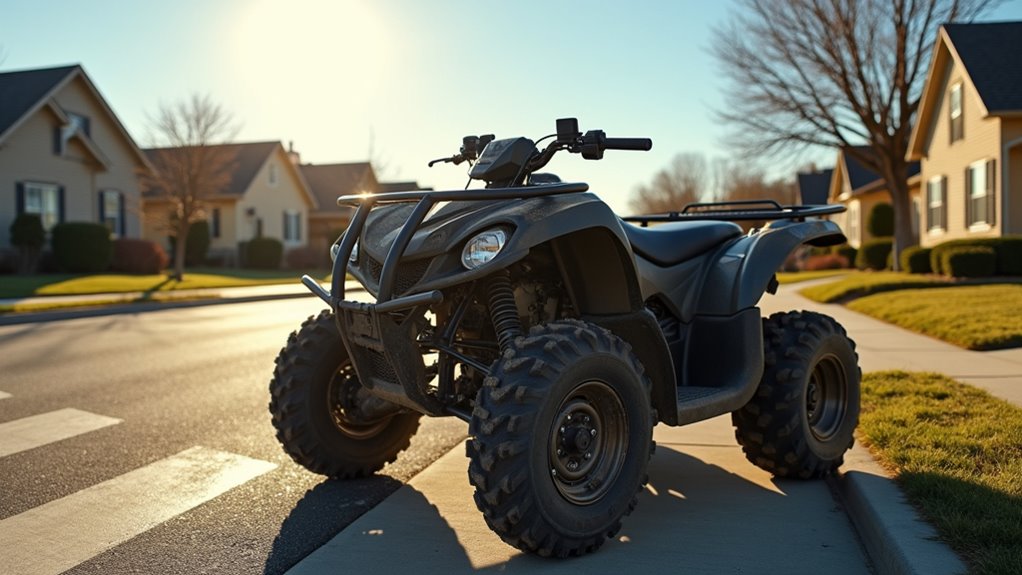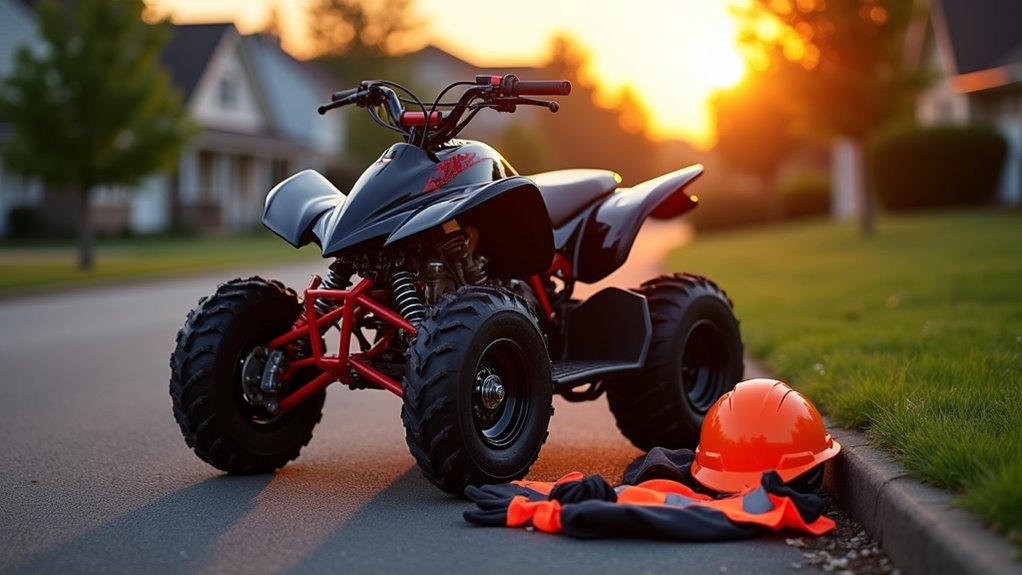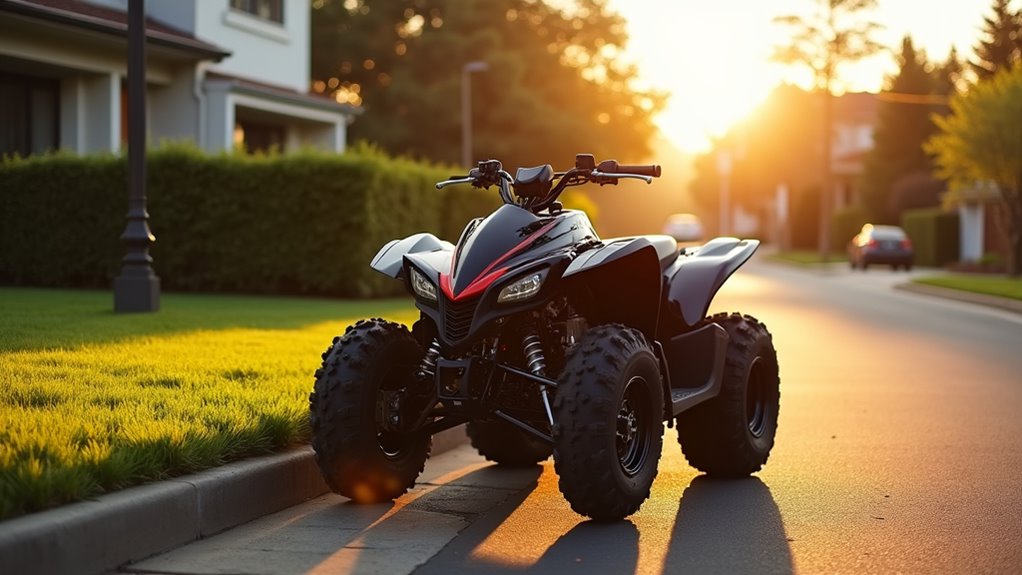Are 4 Wheelers Street Legal
This post contains affiliate links. As an Amazon Associate, we earn from qualifying purchases.
The street legality of 4 wheelers, or ATVs, depends on your location. In states like Arizona and Utah, they are allowed on roads with proper registration and gear, while in places like California and Colorado, they are banned from public roads due to safety concerns. Stay tuned for more detailed information on local laws and safety tips for riding in the sections ahead!
Essential Facts in 30 Seconds
- Street legality of 4-wheelers depends on state laws; always check local regulations.
- Arizona and Utah permit road use with registration and required gear.
- California and Colorado typically ban 4-wheelers on public roads for safety reasons.
- Necessary equipment like headlights, taillights, and mirrors may be required for legal use.
- Some areas allow riding on low-speed roads under 35 mph with local permission.
Understanding ATV Legal Status Across States
Riding an ATV or UTV on public roads sounds super fun. But rules change a lot across the United States. Some states say yes, others say no. In Arizona and Utah, you can ride on roads. Just register your vehicle and add needed gear. They make the process easy for you.
Other places like California and Colorado don’t allow it. They worry about safety and vehicle rules. Some states, like Florida and Kansas, have strict limits. You can only ride on certain roads. Speed limits matter a lot there too. Additionally, states like Idaho require specific documentation such as license plate and insurance for legal road use.
Always check your state’s laws before you ride. ATVs have different classes, and that affects road use. Most times, you need registration and a license.
Equipment like lights and brakes must be on your ride. Stay updated on rules to ride safe and legal. That’s the best way to enjoy your ATV!
Local Permissions and Road Crossing Rules

Let’s dive into local rules and road crossing tips for ATVs in Illinois. Public roads are often off-limits for riding. Some local areas allow it, though. They usually permit ATVs where speed limits stay below 35 mph. Always check the local laws for clear permissions. Don’t skip on insurance—it’s a must for road use.
Safety comes first while crossing roads. Cross at a straight 90° angle every time. Stop completely before you move forward. Look around for cars or people. Additionally, remember that crossing divided highways is only allowed at intersections with public roads at public intersections. Equipping your ATV with winter tires can enhance traction during cold, snowy conditions. Vehicle modifications like wheel spacers must comply with safety regulations to ensure proper handling and stability. Here’s how to do it right:
- Straight Crossing: Line up your ATV directly across the road. Keep the path short and safe.
- Full Stop: Halt at the edge. Check for traffic before going.
- Wait for Others: Let cars and walkers go first. Stay patient.
- Cross at Junctions: Use public road intersections for divided highways.
Stay alert on every ride. Always give way to traffic. Put safety above everything else.
Equipment and Safety Gear Requirements

Get your ATV ready for the road with proper gear. Ensure it meets street-legal rules. Equip your ride with key safety items. Think headlights, taillights, and brake lights. They help others see you clearly. Add rearview mirrors to check behind you. A working horn alerts people nearby.
Stick reflectors on for better visibility at night. They shine in bad weather too. Look up local laws for turn signals. Check if license plate lights are needed. Keep tires at 20 psi or less. Match the right size for safety. Always ensure your vehicle meets the specific safety requirements specified in local ordinances for WATVs. Here’s a simple list of must-haves:
| Equipment | Requirement |
|---|---|
| Headlights | Needed for night rides |
| Taillights | Show when you stop |
| Reflectors | Make you visible |
| Rearview Mirrors | See what’s behind |
Follow these rules to stay safe. Keep your ATV legal on streets!
Best Practices for Safe ATV Operation

Safety comes first when you ride an ATV. Make sure you’re ready for the adventure. Take a certified training course to learn the basics. Keep practicing your skills to stay sharp. Know the maker’s rules for your ATV. Build your own safety habits too.
Always check your ATV before a ride. Look at the brakes, tires, and controls. Understanding different drive systems can also help ensure a safer ride by matching the ATV to the terrain.
Picture these moments to stay safe on trails. Ride steady on rocky paths to avoid tipping. Stay alert on paved roads for cars nearby. Use hand signals in a group to point out dangers. Shift your body on steep hills to keep control.
Never ride after drinking alcohol. Follow the passenger limit on your ATV. Respect the trails and don’t damage them. Control your speed based on ground and weather. Talk clearly with other riders around you.
Stay ready, ride wisely, and have fun! Remember that safety features are often missing on ATVs compared to traditional vehicles, so extra caution is necessary.
Frequently Asked Questions
Can ATVS Be Insured for Street Use?
You can insure your ATV for street use with the right plan! Check out policies that fit street rules and requirements. Make sure you add endorsements for on-road safety. Protection matters a lot—don’t skip it! Many riders secure coverage for peace of mind. Data shows over 60% of ATV owners buy insurance. Stay safe and ride legally with proper plans!
Are There Age Restrictions for ATV Riders?
Age rules for ATV riders matter a lot. Many places limit kids under 16. They often need an adult to watch them. Always look at local laws for clear rules. Some areas might have stricter guidelines. Safety comes first for young riders. Data shows accidents drop with proper supervision. Stick to the age limits for protection. Learn the laws before hitting the trails. Keep everyone safe on every ride.
Do ATVS Require a Driver’s License to Operate?
Always know the rules before riding an ATV. Licensing needs can differ by state. Often, off-road use skips the need for a driver’s license. Still, some places might ask for one. Check your local laws to stay safe. Data shows many states allow ATVs without licenses off-road. Keep yourself informed. Ride smart and avoid trouble!
Can ATVS Be Used on Private Property Legally?
ATVs are legal on private land with the owner’s clear permission. Always obey local ATV rules to stay safe. Respect the property lines and avoid any damage. Breaking rules might stop you from riding there. Stay careful and keep the land in good shape. Data shows many riders lose access due to disrespect. Stick to these tips for a fun, legal ride.
Are There Penalties for Illegal ATV Road Use?
Riding an ATV on the road can lead to big trouble. You might get heavy fines for breaking the law. Legal problems can follow too. Stick to off-road areas to stay safe. Data shows thousands face penalties yearly for this mistake. Avoid the risk. Keep your ATV off public roads.
Conclusion
Riding a 4-wheeler on the street needs caution. Laws change across different states. Always check your local rules first. Safety gear is a must for protection. Learn how to cross roads safely. Data shows many accidents happen without proper care. Stay alert and ride with smarts. Keep your ATV adventure safe and legal. Avoid trouble by knowing the laws. Stay on the right path always.
